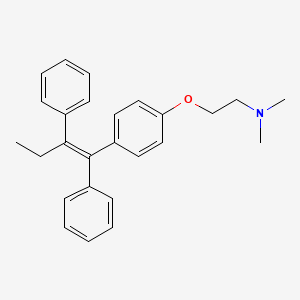Attribution Statement: LactMed is a registered trademark of the U.S. Department of Health and Human Services.
NCBI Bookshelf. A service of the National Library of Medicine, National Institutes of Health.
Drugs and Lactation Database (LactMed®) [Internet]. Bethesda (MD): National Institute of Child Health and Human Development; 2006-.
CASRN: 10540-29-1

Drug Levels and Effects
Summary of Use during Lactation
Tamoxifen and its active metabolites are detectable in milk and accumulate in milk over time. It can also suppress lactation. If a mother requires treatment with tamoxifen, breastfeeding should be avoided.
Drug Levels
Maternal Levels. A nursing mother was diagnosed with breast cancer and started on tamoxifen 20 mg daily at 8 am. Thirty-nine milk samples were collected over 23 days before and after tamoxifen initiation. For the first 15 days, two samples were collected each day, one in the afternoon and one in the evening. For the remaining 8 days, only one sample was collected each day. On day 1 of therapy, tamoxifen was detected in a concentration of 16.5 mcg/L at noon and 13.9 mcg/L at 11 pm. Milk concentrations increased steadily to a concentration of 79.5 mcg/L at an unrecorded time on day 23. Seven metabolites were also monitored and increased over the same time period. The two active metabolites, 4-hydroxytamoxifen and Z-endoxifen also increased over time and reached quantifiable levels at day 18. The authors noted that steady-state might not have been attained at the time of the last milk sample.[1]
Infant Levels. Relevant published information was not found as of the revision date.
Effects in Breastfed Infants
Relevant published information was not found as of the revision date.
Effects on Lactation and Breastmilk
Tamoxifen was more effective than placebo in suppressing lactation and preventing engorgement and pain in two trials in postpartum mothers. Neither study stated what, if any, physical methods (e.g., breast binding) were used concurrently.[2,3] In one study of 80 women, tamoxifen 10 mg four times daily for 5 days during the first week postpartum was more effective than placebo in suppressing a rise in serum prolactin after use of a mechanical breast pump after 5 days of treatment, but not on day 3. All of the women in the study had breastfed a previous child.[2] The other study of 150 women used 2 regimens starting within 2 hours of delivery: tamoxifen 30 mg twice daily for 2 days, followed by 10 mg twice daily for 2 days; and 10 mg twice daily for 14 days. More women in the tamoxifen groups had not previously breastfed an infant.[3]
In a case report, a woman with a history of breastfeeding 4 children (the last having been weaned 10 months earlier) began lactating after 1 week of a cancer chemotherapy regimen for breast cancer that included tamoxifen 20 mg/day. Milk production continued for several weeks until tamoxifen was discontinued after which it did not return during 12 more weeks of chemotherapy.[4]
References
- 1.
- Peccatori FA, Codacci-Pisanelli G, Mellgren G, et al. First-in-human pharmacokinetics of tamoxifen and its metabolites in the milk of a lactating mother: A case study. ESMO Open. 2020;5:e000859. [PMC free article: PMC7594360] [PubMed: 33115771]
- 2.
- Masala A, Delitala G, Lo Dico G, et al. Inhibition of lactation and inhibition of prolactin release after mechanical breast stimulation in puerperal women given tamoxifen or placebo. Br J Obstet Gynaecol. 1978;85:134–7. [PubMed: 626722]
- 3.
- Shaaban MM. Suppression of lactation by an antiestrogen, tamoxifen. Eur J Obstet Gynecol Reprod Biol. 1975;4:167–9. [PubMed: 1053489]
- 4.
- Favis GR, Alavi JB, Glick JH. Lactation from tamoxifen in breast cancer. Ann Intern Med 1979;90:993-4. Letter. PMID: 220899. [PubMed: 220899]
Substance Identification
Substance Name
Tamoxifen
CAS Registry Number
10540-29-1
Disclaimer: Information presented in this database is not meant as a substitute for professional judgment. You should consult your healthcare provider for breastfeeding advice related to your particular situation. The U.S. government does not warrant or assume any liability or responsibility for the accuracy or completeness of the information on this Site.
- User and Medical Advice Disclaimer
- Drugs and Lactation Database (LactMed) - Record Format
- LactMed - Database Creation and Peer Review Process
- Fact Sheet. Drugs and Lactation Database (LactMed)
- Drugs and Lactation Database (LactMed) - Glossary
- LactMed Selected References
- Drugs and Lactation Database (LactMed) - About Dietary Supplements
- Breastfeeding Links
- PMCPubMed Central citations
- PubChem SubstanceRelated PubChem Substances
- PubMedLinks to PubMed
- Review Ethacrynic Acid.[Drugs and Lactation Database (...]Review Ethacrynic Acid.. Drugs and Lactation Database (LactMed®). 2006
- Review Clomiphene.[Drugs and Lactation Database (...]Review Clomiphene.. Drugs and Lactation Database (LactMed®). 2006
- Review Dimenhydrinate.[Drugs and Lactation Database (...]Review Dimenhydrinate.. Drugs and Lactation Database (LactMed®). 2006
- Review Fenofibrate.[Drugs and Lactation Database (...]Review Fenofibrate.. Drugs and Lactation Database (LactMed®). 2006
- Review Pentazocine.[Drugs and Lactation Database (...]Review Pentazocine.. Drugs and Lactation Database (LactMed®). 2006
- Tamoxifen - Drugs and Lactation Database (LactMed®)Tamoxifen - Drugs and Lactation Database (LactMed®)
Your browsing activity is empty.
Activity recording is turned off.
See more...
